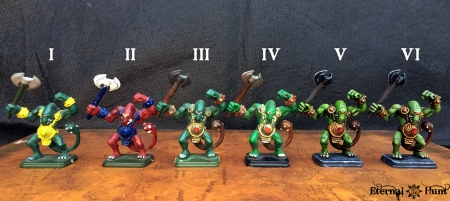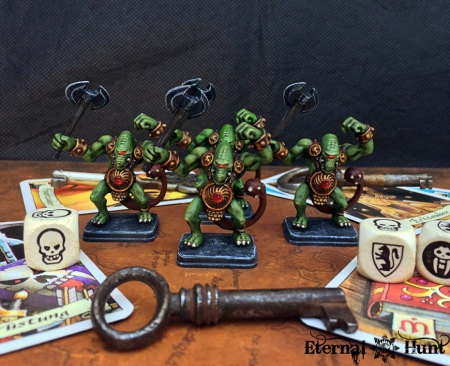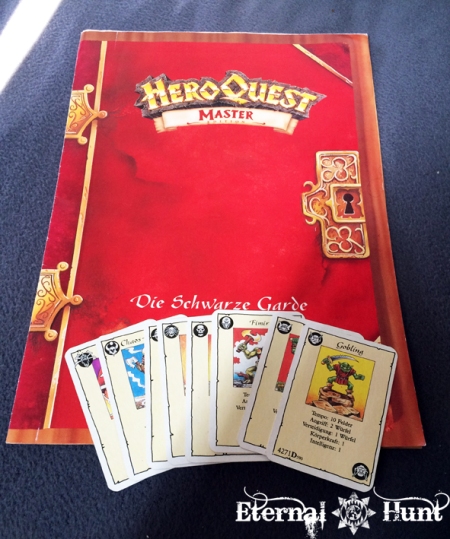It’s back to HeroQuest this week, as my #HeroQuest2019 project slowly but surely reaches the home stretch, and I have some new models to share with you. So let’s not waste any time and get right into the meat of things, shall we?
When we last talked about progress on my HeroQuest set, I still had to paint two more monster types: the Goblins and the Fimir (Fimirs? Fimirach?). I won’t lie, I wasn’t exactly looking forward to painting yet more green, but I also realised that I had to power through those models before ending fatigue set in.
Fortunately enough, fellow hobbyist Weltenlaeufer provided me with the perfect kickstart to my efforts over at the Ye Olde Inn forum: He inquired after my recipe for painting greenskins, and in order to answer him, I posted a step by step tutorial for my Goblins and also used this as the perfect opportunity to actually get those Goblins painted at the same time — pretty smart, eh?
[In case anyone’s interested, the full tutorial can be found here. I don’t really want to reproduce it here, mostly because it’s mostly based on A Gentleman’s One’s fantastic greenskin recipe anyway).]
And so a short while later, the Goblins were finished:
While the recipe for the skin and weapons is very similar to the approach I used for my HeroQuest Orcs, I decided to paint the Goblins’ clothes in a slightly more colourful manner — it makes for some added visual variation, for one, and also helps to differentiate the Goblins from their larger cousins. I think it also fits that the small, wily Goblins should be a bit more into fashion concerns than their lumbering Orc relatives… 
So here’s a look at all of the HeroQuest greenskins:
So that left just one type of monster, and I had good reason for leaving this one for last: the Fimir.
Now the Fimir are an interesting colourful touch in HeroQuest’s bestiary, in that they do fulfil the role of the classic lizardman, but with a twist. They are cyclopean, for one, and their armour has always struck me as interestingly mesoamerican — but maybe I am just overthinking things here. Anyway, my main point of reference for the models’ paintjob was, once again, the classic Mike McVey approach, seen here on a prototype model that also appears on the back of the quest book:

This is the prototype Fimir as he still looks today, in Bryan Ansell’s private collection. I nabbed the picture from RealmofChaos80s.
But the truth is that the actual Fimir models contained in the HeroQuest boxed set are not quite on par with the prototype. Now this is definitely true for some of the other monsters as well, but by and large, most of them work really well on their own, especially given the relatively unsophisticated one-piece mono-pose nature of the HeroQuest models.
The Fimir, however, definitely get the short end of the stick in this respect: The models are weirdly clunky and ungainly, with lots of weird angles and strange lines. To wit, the mere act of cleaning the mold lines off those models was an exercise in frustration! Some of the detail from the prototype model is either far softer on the production models or nowhere to be seen at all. So I would have to deal with that issue during the painting process.
At the same time, finding an actual painting recipe that worked also took some doing — in hindsight, it’s funny how I actually have so many different test models for painted Fimir in my collection. In fact, for an extra bit of fun, here’s an evolution of my various Fimir models over the years:
I and II weren’t even painted by me, but by the first of my friends to dabble in miniature painting, back in elementary school. I think he was onto something with the red Fimir, though, and if I should ever paint another set of Fimir, I think I’ll be going for an alternate scheme like that (this would also be a cool way of suggesting different tribes or broods of Fimir, seeing how they are lizard people and everything…). III was the first Fimir I painted (with scale model acrylics, no less). IV was painted with Citadel colours, but I’m not quite sure what I thought I was doing there — I seem to have had a pretty bad painting streak during the early-to-mid 90s, in hindsight. V and VI are my modern attempts that we will be taking a closer look at in a second:
So here’s my first “modern” Fimir model painted some time last month, in order to nail down a painting approach:
The main colour I used for the skin was GW Moot Green, and it ended up looking…very green. I also became too greedy for a quick recipe during the painting process, and didn’t spend nearly enough time carefully layering on the skin colour, adding some pretty slapdash higlights on top, instead. All of this lead to a pretty rough looking model, at least where the skin was concerned.
At the same time, there were also some parts that I was pretty happy with: The golden armour works pretty well, as does the obsidian-style axe, if you ask me. And I think the red jewel that adorns the belly plate actually came out pretty well. But whichever way you want to cut it, I would need to tweak the recipe on the second attempt. Which is what I did this past weekend. Take a look:
The difference seems subtle at first, but I would argue the skin works quite a bit better: The higlights have been layered on more carefully (and in several steps), and the overall skin tone – created by mixing GW Warboss Green and GW Elysian Green in various ratios (starting with 70:30, then 50:50, then something more like 30:70) – makes the Fimir look a little less cartoony and more like a somewhat crocodilian swamp dweller. At the same time, I kept most of the touches that had worked well before, such as the golden armour and the axe looking as though it was made from some kind of obsidian or volcanic glass.
I also painted three models at the same time, in order to finish the last missing monsters for my HeroQuest collection:

And while the test model does look a bit different, it can still be used to fill out the ranks:
As a matter of fact, fellow hobbyist PDH has offered to send over three more Fimir models from his own collection, which will give me the opportunity to either tweak the recipe yet again or – more likely – go for something completely different to hint at a different subspecies of Fimir.
In any case, that means all of the “green” monster models from the base game are now officially complete:
And, even better, with that, I have actually managed to paint all the models in the classic HeroQuest Game System:


And here’s the entire HeroQuest collection so far, with some extra monsters to round out the bestiary as well as the added characters, such as Sir Ragnar and the Witch Lord. Quite a few models, if I do say so myself — and almost all of them have been painted in 2019! Take a look:

Honestly, I never thought I’d see the day — this project has been thirty years in the making, and it’s also a bit of a childhood dream come true, to be honest. When lining all of those little guys up for the photo, I couldn’t stop grinning 
And still, that’s not quite the end of this project yet: I do have a couple of ideas for additional models (and there are still those Master Edition men-at-arms to take care of), for one. Before that, however, I’ll have to deal with all of the HeroQuest furniture — something I am actually looking forward to quite a bit, and I am in fact already hard at work on the first pieces!
For now, however, I am incredibly happy with the models I have managed to complete so far:

Also, on a related note, my friend Annie was wonderful enough to let me have some more leftovers from her extra copy of HeroQuest, namely the monster cards and Master Edition questbook, which brings me one step closer to owning a complete set again:
So that’s another huge chunk of #HeroQuest2019 out of the way — it actually looks like I may get to take the completed set for a spin this very year — who would have expected that, eh? 
Of course I would love to hear any thoughts or comments you may have, so drop me a line! And, as always, thanks for looking and stay tuned for more!











